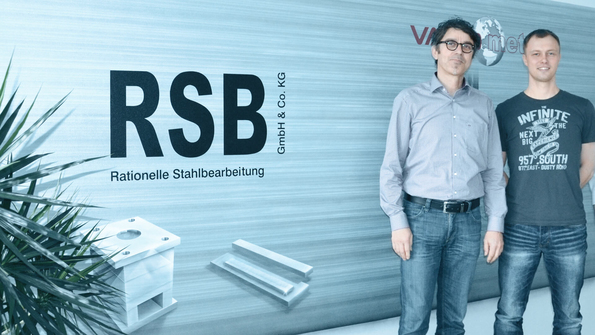-
Software
-
CAM software
- Tebis Automill
- CNC programming
- CNC automation
- CNC simulator
- Multiple setup
- Robotic machining
- CNC drilling
- Deep-hole drilling
- Combined turn-milling
- CNC turning
- Turn-milling
- 2.5D milling
- 3D milling
- 5-axis milling
- Slot milling
- Trimming
- HPC milling
- HFC milling
- Circle-segment cutters
- Sinker EDM
- Wire EDM
- 3D laser cutting
- Laser hardening
- Laser weld cladding
- CAD software
- CAQ software
- MES software
- Products
-
CAM software
- Services
- Consulting
- Sectors
- References
- Company
- News

-
 Home References
Home ReferencesFaster to the machine with the 2.5D process solution from Tebis
Interview with Arno Volkmar and Ralf Wünsch, RSB Rationelle Stahlbearbeitung
RSB Rationelle Stahlbearbeitung, a medium-sized company in Merkers, Thuringia, relies completely on Tebis software solutions for its NC programming. We took a closer look at Tebis's automated 2.5D process during a discussion with sales manager Arno Volkmar and NC programmer Ralf Wünsch.
Mr. Wünsch, why do you use the 2.5D process solution from Tebis?
Ralf Wünsch: Originally, we only generated 3D programs with Tebis. But 2.5D machining was absolutely necessary, especially in manufacturing our components with large prismatic portions. So we took a closer look at the 2.5D solution from Tebis. And what was the result?
Ralf Wünsch: Outstanding.
Specifically?
Ralf Wünsch: Tebis generates so-called "features" from purely geometrical elements such as holes, pockets and threads. Features are directly linked to a machining specification; the corresponding milling strategies are already stored. The machining specification accounts for various steps such as "drilling," "countersinking" and "thread forming." These are steps for the machine types, the material group or the tool to be used. The programmer only needs to select the correct template.
Isn't that somewhat rigid? Not all of the tools or machines are always available when needed. And holes are not always equally deep.
Ralf Wünsch: The amazing thing about the Tebis solution is the variable approach. Most of the machining parameters and tools can be described as variable. Machines and materials can be combined in groups. For example, consider a tool description: You can use various tools for a machining operation within given limits. Neither the programmer nor the machine operator have to think in advance about whether a specific tool will actually be available at the time of manufacturing.
OK, so the process is simpler. But there's an incredible amount of knowledge stored in these libraries and templates. This all has to be input somehow. Did you prepare the libraries and templates all by yourself?
Ralf Wünsch: No. Tebis Implementation helped us with this. The libraries and templates were prepared over roughly 20 days. Another colleague and I were closely involved in this process. Then there were eight project management days. Five NC programmers and two employees from data processing attended a special training program.
Wasn't that pretty expensive? Mr. Volkmar, what do you think of this as a sales manager?
Arno Volkmar: Well, our boss, Thomas Müller, always says, “In the end, it's not the cheapest solution, but the most cost-effective one that counts.” And the cost-to-benefit ratio is outstanding. NC programs that we used to prepare in 40 to 60 minutes now only take 10 to 15 minutes to generate. The components get to the machine faster. The high degree of standardization prevents errors, and the quality standard remains high throughout. Standard tools are consistently used, significantly reducing tool costs.
You mentioned before that you didn't send just NC programmers to this training but data processing employees as well. Why?
Arno Volkmar: This is very closely related to our organizational structures. In our company, work preparation is performed in the data processing department. This is also a big advantage of the automation and high degree of user-friendliness. Work preparation is now much more closely integrated in the NC process. We have moved some work steps forward. For example, data import and feature assignment of the holes are performed entirely in work preparation. The programmers assign features to the pockets to be milled, and assign the corresponding machining specification. All of this is accomplished in a highly efficient process that benefits us greatly, and that we could no longer do without in our daily work.
Mr. Volkmar, Mr. Wünsch, thank you for this conversation.
 Finished part in quality testing
Finished part in quality testing Sales manager Arno Volkmar (left) and NC programmer Ralf Wünsch (right).Read success story
Sales manager Arno Volkmar (left) and NC programmer Ralf Wünsch (right).Read success storyClick here to see the complete user report from RSB Rationelle Stahlbearbeitung.
